How To Get Rid Of Black Scabs On Dog
Slideshow: Pare Issues in Dogs

Dog Skin Problems
ane/xix
The sound of a dog constantly scratching or licking can exist as irritating as nails on a chalkboard. Just don't blame your pooch for these bad habits -- a skin condition is probably the culprit. Possible causes range from parasites to allergies to underlying affliction. WebMD has compiled images of some of the most common canine pare problems.
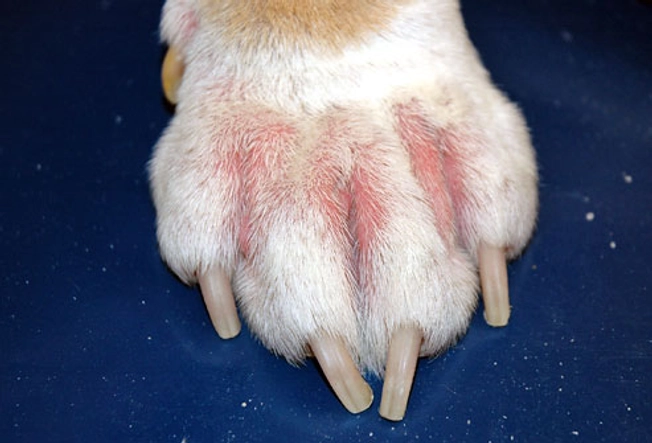
Allergic Dermatitis
ii/xix
Dogs tin can have allergic reactions to training products, food, and environmental irritants, such as pollen or insect bites. A domestic dog with allergies may scratch relentlessly, and a peek at the skin ofttimes reveals an ugly rash. Corticosteroids or other, newer medicines can assist with itchy rashes. But the most constructive treatment is to identify and avoid exposure to the allergens.
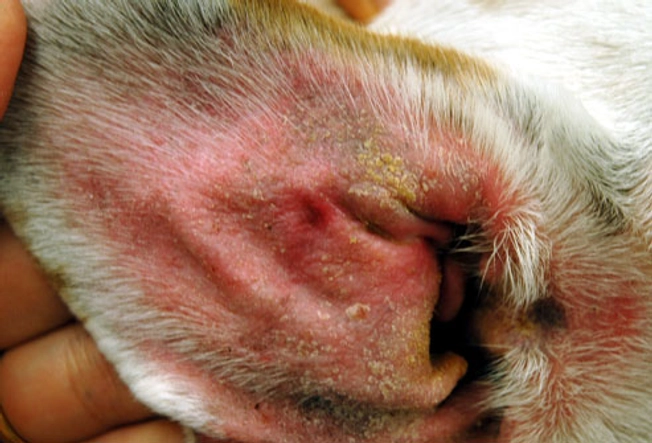
Yeast Infection
3/19
If your dog can't seem to cease scratching an ear or licking and chewing their toes, ask your veterinarian to cheque for a yeast infection. Symptoms include irritated, itchy, or discolored skin. The infection usually strikes the paws or ears, where yeast have a cozy infinite to grow. Yeast infections are like shooting fish in a barrel to diagnose and often respond well to a topical cream. In some cases, your veterinarian may prescribe oral drugs, medicated sprays, or medicated baths.
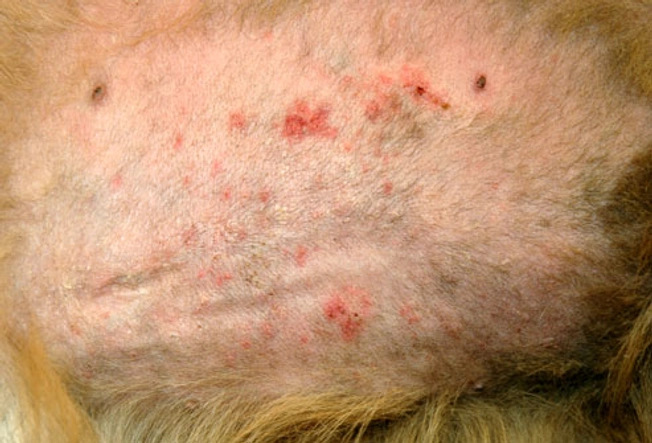
Folliculitis
4/nineteen
Superficial bacterial folliculitis is an infection that causes sores, bumps, and scabs on the skin. These peel abnormalities are easier to come across in shorthaired dogs. In longhaired dogs, the near obvious symptoms may be a dull coat and shedding with scaly skin underneath. Folliculitis often occurs in conjunction with other skin problems, such every bit mange, allergies, or injury. Treatment may include oral antibiotics and antibacterial ointments or shampoos.
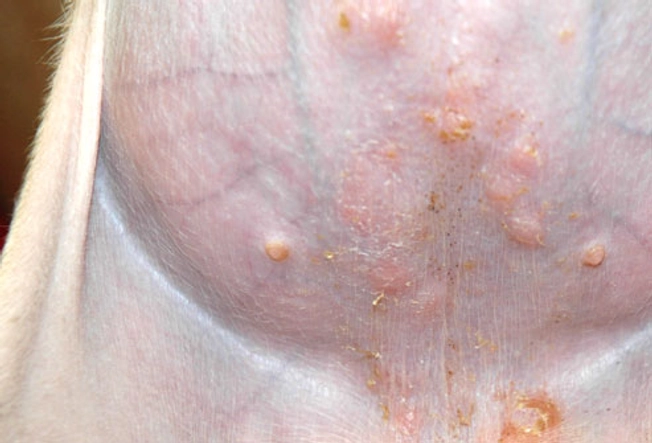
Impetigo
5/xix
Another blazon of bacterial infection, impetigo is about common in puppies. It causes pus-filled blisters that may pause and crust over. The blisters normally develop on the hairless portion of the abdomen. Impetigo is rarely serious and can exist treated with a topical solution. In a small number of cases, the infection may spread or persist.
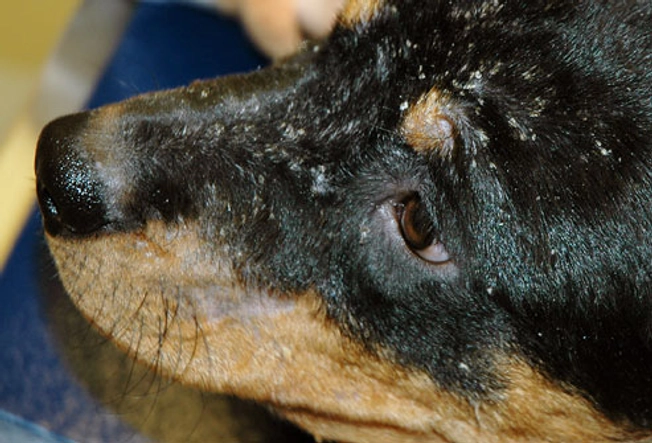
Seborrhea
6/19
Seborrhea causes a dog's skin to go greasy and develop scales (dandruff). In some cases, it'south a genetic illness that begins when a dog is young and lasts a lifetime. But most dogs with seborrhea develop the scaling every bit a complication of another medical problem, such equally allergies or hormonal abnormalities. In these cases, it is vital to care for the underlying cause so symptoms do not recur. The seborrhea itself typically can exist treated with certain medicated shampoos.
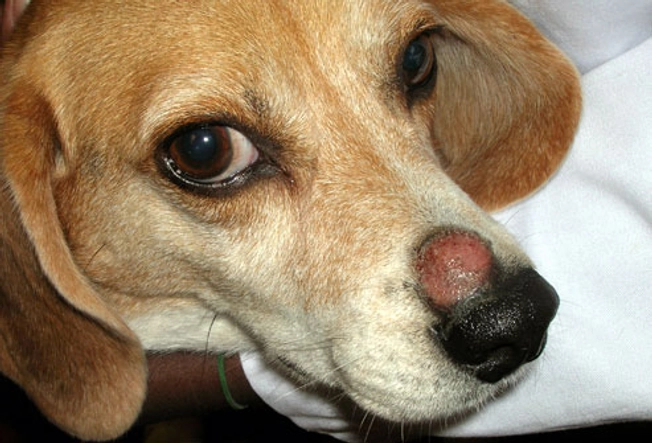
Ringworm
7/19
Despite its name, ringworm is non caused by a worm, merely by a fungus. The term "ring" comes from the circular patches that can class anywhere, only are often institute on a domestic dog's caput, paws, ears, and forelegs. Inflammation, scaly patches, and hair loss often environment the lesions. Puppies less than a twelvemonth old are the nearly susceptible, and the infection tin can spread quickly betwixt dogs in a kennel or to pet owners at habitation. Various anti-fungal treatments are bachelor.
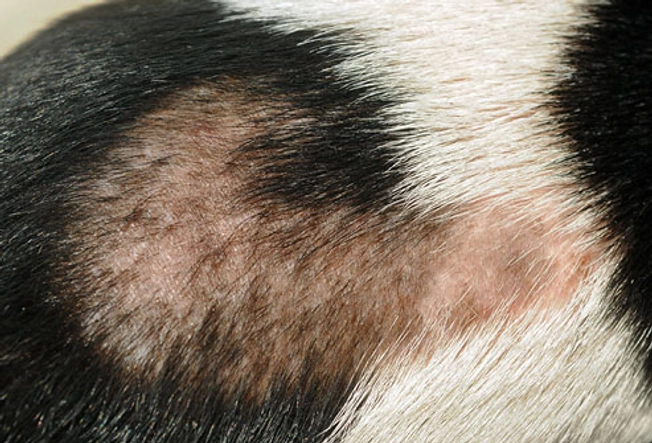
Shedding and Pilus Loss (Alopecia)
8/19
Anyone who shares their dwelling house with dogs knows that they shed. How much shedding is normal depends on brood, time of twelvemonth, and environment. But sometimes stress, poor nutrition, or illness can cause a canis familiaris to lose more hair than usual. If abnormal or excessive shedding persists for more than a week, or you notice patches of missing fur, check with your veterinarian.

Mange (Mites)
9/19
Mange is a skin disorder caused by tiny parasites called mites. Sarcoptic mange, also known as canine scabies, spreads hands among dogs and can as well exist transmitted to people, merely the parasites don't survive on humans. The symptoms are intense itching, red skin, sores, and hair loss. A domestic dog'southward ears, face up and legs are about commonly affected. Demodectic mange can cause bald spots, scabbing, and sores, but information technology is non contagious betwixt animals or people. Treatment depends on the type of mange.

Fleas
10/19
Fleas are the bane of whatsoever pet owner. You may not come across the tiny insects themselves, but flea droppings or eggs are usually visible in a canis familiaris's coat. Other symptoms include excessive licking or scratching, scabs, and hot spots. Severe flea infestations tin can crusade claret loss and anemia, and even expose your dog to other parasites, such every bit tapeworms. Treatment may include a topical and/or oral flea killer and a thorough cleaning of the pet'due south home and yard.

Ticks
xi/19
Ticks, like fleas, are external parasites that feed on the blood of their hosts. You can spot a tick feeding on your domestic dog with the naked center. To properly remove a tick, grasp the tick with tweezers close to the dog's pare, and gently pull it straight out. Twisting or pulling also hard may crusade the head to remain lodged in your dog'due south peel, which can lead to infection. Place the tick in a jar with some alcohol for a couple of days. If your pet gets ill, your vet may need information technology to analyze what's incorrect. In addition to causing blood loss and anemia, ticks can transmit Lyme illness and other potentially serious bacterial infections. If you live in an area where ticks are common, talk to your veterinarian nigh tick control products.
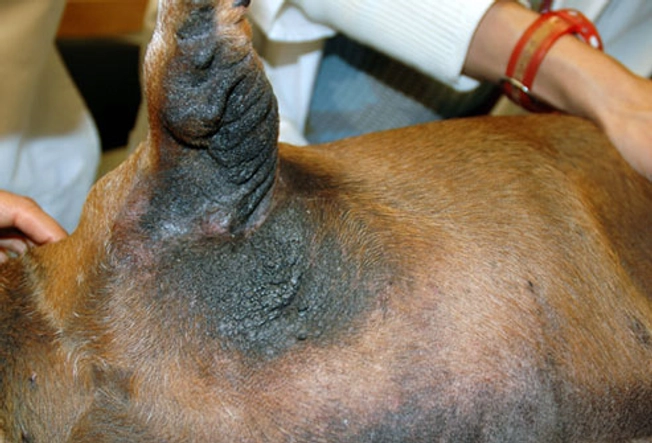
Color or Texture Changes
12/xix
Changes in a dog'south pare color or glaze texture can exist a warning sign of several common metabolic or hormone problems. They can also result from an infection or other skin disorder. Ordinarily a simple blood examination can identify the underlying cause. Be sure to inquire your veterinarian about any pregnant changes to your dog's coat.

Dry, Flaky Skin
thirteen/nineteen
Dry, flaky skin can be a carmine flag for a number of problems. It's a common symptom of allergies, mange, and other pare diseases. Only nearly often, dry or flaky skin is null serious. Make sure you lot are feeding Fido high quality food. Similar people, some dogs simply get dry out skin in the winter. If this seems to crusade your pet discomfort, consult your veterinarian. Ask whether a fat acid supplement or a humidifier might help.
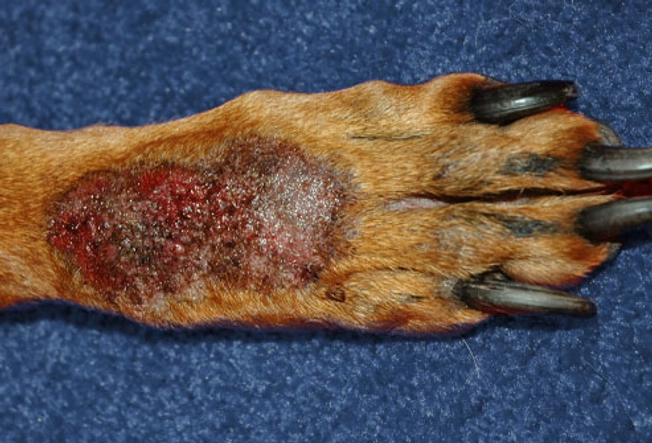
Acral Lick Granuloma
xiv/19
Also chosen acral lick dermatitis, this is a frustrating skin condition caused past compulsive, relentless licking of a unmarried area -- well-nigh often on the front of the lower leg. The expanse is unable to heal, and the resulting pain and itching tin can atomic number 82 the dog to keep licking the same spot. Handling includes discouraging the canis familiaris from licking, either by using a bad-tasting topical solution or an Elizabethan collar. Also ask your dog's vet about other treatment options.
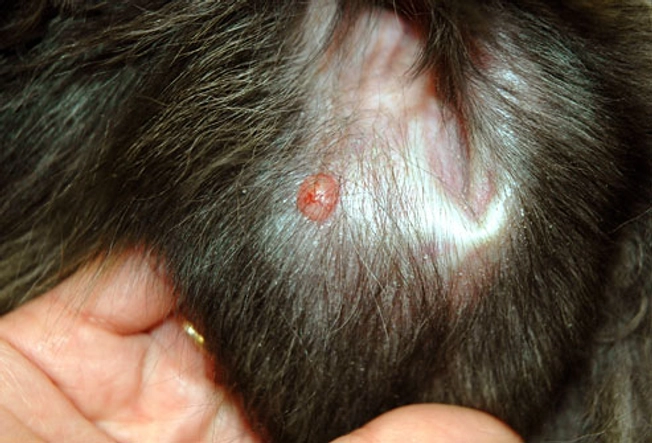
Skin Tumors
15/xix
If you observe a lump on your dog'southward skin, bespeak it out to your vet equally before long as possible. Dogs can develop malignant tumors in their skin. The only way to ostend a diagnosis of cancer is to biopsy the tumor. If the lump is modest enough, your veterinary may recommend removing it entirely. This can yield a diagnosis and treatment with a single procedure. For tumors that take not spread, this may be the just treatment needed.

Hot Spots
xvi/19
Hot spots, also called acute moist dermatitis, are small areas that appear red, irritated, and inflamed. They are most commonly establish on a dog's head, hips, or breast, and frequently feel hot to the impact. Hot spots tin can result from a wide range of conditions, including infections, allergies, insect bites, or excessive licking and chewing. Treatment consists of cleansing the hot spot and addressing the underlying status.
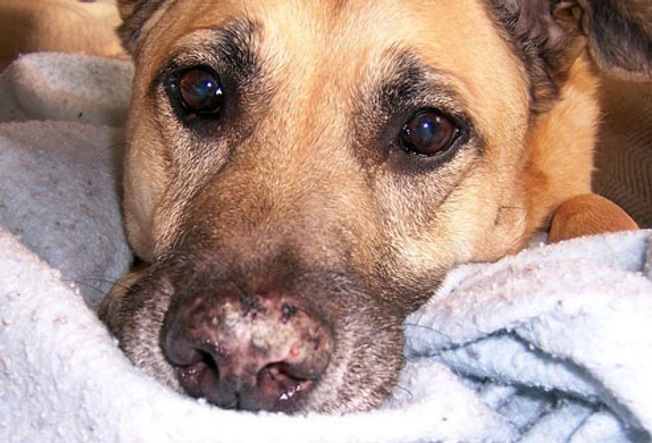
Immune Disorders
17/19
In rare cases, skin lesions or infections that won't heal can indicate an immune disorder in your dog. Ane of the best known is lupus, a disease that affects dogs and people. Lupus is an autoimmune disorder, meaning the body's allowed system attacks its own cells. Symptoms include skin abnormalities and kidney problems. It tin can be fatal if untreated.
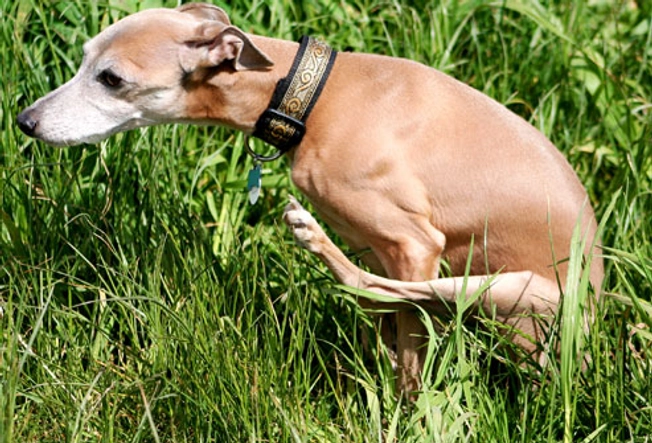
Anal Sac Disease
eighteen/19
Equally if canis familiaris poop weren't smelly enough, dogs release a foul-smelling substance when they exercise their business. The substance comes from small anal sacs, which can get impacted if they don't empty properly. The hallmark of impacted anal sacs is a domestic dog scooting their bottom along the ground. Other symptoms include biting or licking the anal area. A vet can manually express total anal sacs, but in severe cases, the sacs may exist surgically removed.
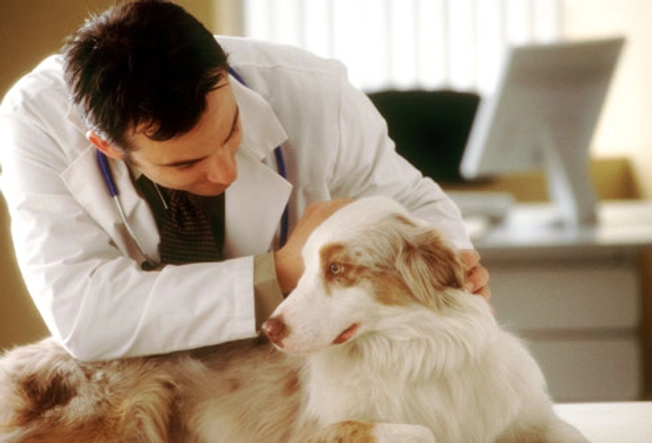
When to See the Vet
19/19
Although virtually skin problems are not emergencies, it is important to get an authentic diagnosis then the condition can be treated. See your veterinarian if your canis familiaris is scratching or licking excessively, or if you lot find any changes in your pet's coat or skin, including scaling, redness, discoloration, or bald patches. Once the cause is identified, about skin problems respond well to treatment.
IMAGES PROVIDED BY: (ane) Lorado / iStock SOURCES: American Society for the Prevention of Cruelty to Animals (ASPCA): "Dog Care – Pare Problems," "Dog Care – Hot Spots," "Dog Intendance – Ringworm," "Dog Care – Shedding," "Dog Care – Fleas," "Canis familiaris Care – Mange," American Society for the Prevention of Cruelty to Animals (ASPCA): "Domestic dog Care – Lyme Disease." DogChannel.com: "Anal Sac Impaction," "Cavalier King Charles Spaniel Allergy and Peel Problems," "Canis familiaris Licking Toes? Look for Yeast Infection," "Dog Peel Weather condition: Allergies," "Dog Skin Conditions: Bump, Lump or Tumor?" "Dog Skin Conditions: Superficial Bacterial Folliculitis," DogChannel.com: "Flaky, Oily or Dry Skin in Dogs." Kathy Snyder, DVM, Internal Medicine and Emergency/Critical Intendance, Texas A&M Academy College of Veterinary Medicine. PetEducation.com: "Acral Lick Dermatitis/Granuloma." The Merck Veterinary Manual: "Anal Sac Illness," "Seborrhea: Introduction." Show Sources
(2-7) Cornell Academy, College of Veterinary Medicine
(8) Nancy MacLeod, flickr
(9-ten) Cornell University, College of Veterinary Medicine
(11) Lauree Feldman / Alphabetize Stock Imagery, Kenneth H. Thomas / Photo Researchers, Inc.
(12-16) Cornell University, Higher of Veterinary Medicine
(17) Photo Courtesy of Kathy Moberly, flickr
(18) Photograph Courtesy of Ingunn Markiewicz / flickr
(19) © Jose Luis Pelaez, Inc./Corbis
Source: https://pets.webmd.com/dogs/ss/slideshow-skin-problems-in-dogs

0 Response to "How To Get Rid Of Black Scabs On Dog"
Post a Comment